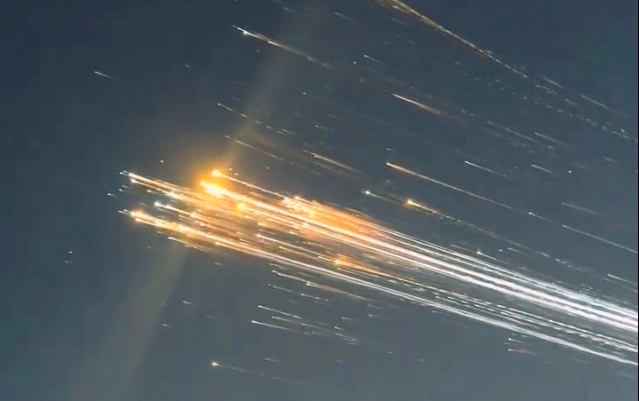A SpaceX Starship rocket broke up in space eight minutes after launching from Texas in the United Sates yesterday (Thursday) forcing airline flights over the Gulf of Mexico to alter course to avoid falling debris and setting back Elon Musk's flagship rocket programme which is ultimately designed to transport people to Mars.
The SpaceX launch from south Texas at 1738 local time (2238 GMT) was carrying its first test payload of mock Starlink satellites but no crew and came just hours after a successful debut launch of the New Glenn rocket developed by rival Blue Origin.
Videos posted on social media showed the upgraded Starship 7 spectacularly disintegrating in a shower of flames over the Turks and Caicos Islands in the Caribbean. SpaceX, describing the explosion as “a rapid unscheduled disassembly” said debris had fallen “into the Atlantic Ocean within the predefined hazard areas”.
The US Federal Aviation Administration (FAA) has launched an investigation and was reported to have briefly slowed and diverted aircraft around the area where the debris was falling after issuing a warning to pilots. Flight-tracking websites also recorded commercial flights in the area diverting immediately after the explosion.
In a post on his social media platform X, Elon Musk, SpaceX’s outspoken CEO, stated: “Preliminary indication is that we had an oxygen/fuel leak in the cavity above the ship engine firewall that was large enough to build pressure in excess of the vent capacity.
“Apart from obviously double-checking for leaks, we will add fire suppression to that volume and probably increase vent area. Nothing so far suggests pushing next launch past next month.”
The question of whether SpaceX can launch its next Starship mission in February rests largely with the FAA) investigation and what findings it reports.
Whilst the seventh Starship mission ended in catastrophic failure, the company did manage to execute a spectacular and successful “catch” of the flight’s rocket booster on its return to Earth at the launch tower.
Meanwhile, just hours earlier on the same day and after many years of delay, Jeff Bezos's firm Blue Origin reached orbit with the first launch of its New Glenn rocket from Cape Canaveral Space Force Station in Florida.
Despite the successful orbit and deployment, Blue Origin failed to land the first stage booster, which is designed for reuse, on a platform in the Atlantic Ocean.
“I’m incredibly proud New Glenn achieved orbit on its first attempt,” said Blue Origin CEO Dave Limp. “We knew landing our booster at the first try was an ambitious goal but we’ll learn a lot from today and try again at our next launch this spring.”
Blue Origin’s successful maiden launch is a marker in the commercial space launch business that Jeff Bezos’s space company is capable of challenging the dominance of SpaceX in the lucrative private space launch business.
New Glenn is part of the deployment plan for Amazon’s Project Kuiper mega constellation, with 12 launches booked back in 2022. Other customers waiting in the wings include NASA, Telesat’s Lightspeed constellation and AST SpaceMobile.
The same day launches were not the only ones of the week after SpaceX kicked off its own busy week that featured flights from all four of its launch pads in California, Florida and Texas.
First up was the Starlink 12-4 mission, which launched from Space Launch Complex 40 (SLC-40) at Cape Canaveral Space Force Station on Monday (13 January).
A day later, SpaceX launched its Transporter-12 rideshare mission from Vandenberg Space Force Base in California delivering 20 cubesats and 14 microsats to orbit for its customers across 17 countries. Then, in the early hours of Wednesday morning a Falcon 9 rocket launched a dual-lunar landing mission from Launch Complex 39A at the Kennedy Space Center in Florida.
Back at the start of the week, China launched a Jielong-3 solid rocket from a mobile sea platform late on Sunday, successfully placing 10 Centispace navigation enhancement satellites into orbit. The fifth Jielong-3 (Smart Dragon-3) solid propellant rocket lifted off from a specially converted sea barge off the coast of Haiyang city, in the Eastern province of Shandong.
Rounding off an incredibly busy week for space launches, today (Friday) China also sent a Pakistani satellite into space from the Jiuquan Satellite Launch Center in Northwest China. The #atellite, named PRSC-EO1, was launched at 1207 (Beijing Time) by a Long March 2D carrier rocket and entered its planned orbit successfully.
# # #
Editor’s comment: With a plethora of launches in a single week the space industry at large needs to ask the question of how sustainable and safe for the environment it all is? Space debris in orbit is already a massively growing problem and commercial aircraft are now increasingly having flights delayed or diverted due to the threat of falling debris during rocket launches.











